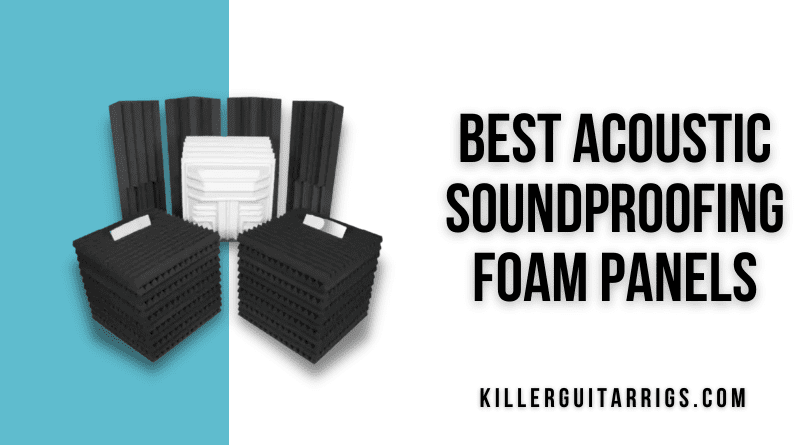If you’ve been struggling to gain control over your home studio, despite adding soundproof curtains, carpeting, rugs, throw pillows, or any other soft furnishings you could find, it’s probably time you considered investing in a purpose-made set of acoustic soundproofing foam panels.
The addition of quality soundproofing can make a world of difference to how you sound, which is particularly important if you’re planning to record. But even in a practice space, foam panels will let you hear more of what you want, and less disruptive echo.
In this KGR Review, we’ve covered 5 of the top soundproofing panels available, and tested them in our home studio. Our space is a carpeted 10’ x 11’ room with a workstation and office chair. We removed all other wall hangings in preparation for these reviews. Our acoustic guitar was recorded with an Aston Origin large diaphragm cardioid condenser set up about 12” from the 15th fret.
The vocals were recorded on a Shure SM57. We used the same SM57 for our electric guitar close-mic rig and played through our Stage Right 5w tube amp. Where possible, we used manufacturer’s recommendations for where to place the panels, but in other cases we used best practice.
Read more about our review process.
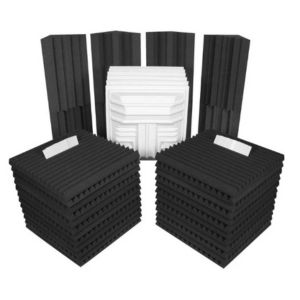
Auralex Deluxe Plus Roominator Kit
Features: LENRD Bass traps, T'Fusor 3D sound diffusers, Studiofoam wedges
Benefits: Full turnkey package, Free online room analysis, Incredible sound absorption
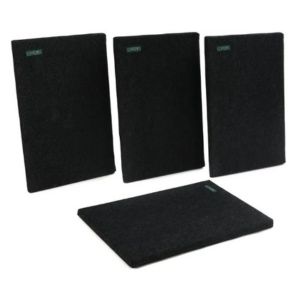
ClearSonic S2233 SORBER Panels
Features: Fiberglass construction, Velcro receptive cover, Ceiling/wall mounting options
Benefits: Outperforms industry standard by 50%, Versatile range of applications, Subtle aesthetics
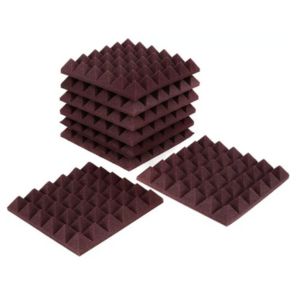
Gator Acoustic Pyramid Panels
Features: 3 Color options, Noise Reduction Coefficient of 0.45, Class A fire rating
Benefits: Solid acoustic performance, Extremely affordable, Provides excellent monitoring accuracy
Contents
Our Top 3
Our top pick in this test were the Clearsonic S2233 SORBER Panels. They offered excellent resistance to sound bleed and did a great job of killing unwanted room effect.
If you aren’t looking to spend a lot, consider our Best Value pick, the Gator 12×2 Acoustic Pyramid Panels. They were basic, but still significantly reduced sound bleed during the test and performed very well considering their low price.
For those of you looking for the very best on the market, regardless of cost, we can’t say enough good things about the Auralex Alpha DST Roominator Kit. It contains everything you need to completely control the sound in your home, or even your studio.
Individual Reviews
Clearsonic S2233 SORBER Panels – Our Top Pick

Top-quality acoustic panels built to last.
After extensive testing, we awarded our top pick to the Clearsonic S2233 SORBER panels. Our first observation was how substantial these panels were! They were definitely amongst the heaviest we tested, due to their fiberglass and heavy-duty carpet construction. But as we highlighted in our best soundproofing curtains piece, the higher the mass of a soundproofing material, the more effective it is at absorbing noise.
We set these panels up with one on each wall in our test room and started playing. They did a great job of cutting down the live-room echo without killing it altogether, which we really liked on our acoustic and vocal testing. On the acoustic and vocal recording, we got some really nice room effect while avoiding excessive echo.
Next, we set up a close mic on our amp and played clean and distorted at high volume on an Epiphone SG Standard. The panels did a good job with cutting out some of the unwanted noise, but to get a truly clean recording you’ll definitely want to look into installing more than 4 panels. On the distorted recording, we found that having the panels up really helped reduce muddiness, without cutting out too much of the bottoms and mids.
As expected, having just these 4 panels up didn’t stop the sound from bleeding into adjacent rooms, but it did appreciably reduce it.
As far as style goes, if you’re looking to hang these in a non-dedicated studio space, a living room or bedroom for example, they are some of the best-looking panels on the market. They’re well-made, look fairly inconspicuous, and the heavy-duty carpeted exterior won’t disintegrate over time like some of the lower-quality open-cell foam tends to.
Verdict: These Clearsonic S2233 SORBER panels are a great option if you’re looking for soundproofing panels that look good in any room and have the performance to match the style. We found them to be best for acoustic and vocal recordings, but they’re still very much useable on electric recordings.
Gator 12” x 12” Acoustic Pyramid Panels – Best Budget Option
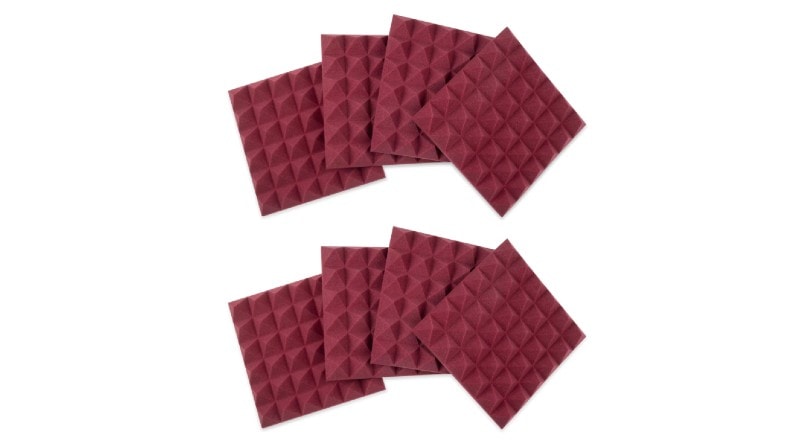
Great performance and a price to suit all budgets.
These Gator Frameworks acoustic pyramid panels are what most players typically think of when you mention soundproofing panels. They’re made from soft, pliable foam and because they’re so lightweight, you can mount them anywhere without having to search for studs. Our trial panels were finished in a really attractive burgundy color, but they have bright red and charcoal available as well.
We had an 8-pack of these panels to try, so we set them up 2 to each wall. Starting with live-room noise, we found that these panels did help with echo reduction, although not quite to the same extent as some of the more premium options on test. Regardless, the acoustic and vocal recording turned out great, with a nice amount of natural room reverb, without harsh slap echo.
With a close-mic setup on the amp and a clean mix, the recording turned out much better than expected. With only 8 panels, we weren’t able to entirely eliminate slap from the recording, but it still provided a much better end result than the room with no panels. When we played with distortion, we had perceptible note separation and good clarity.
There was little prevention of bleed-through into adjacent rooms, but with more panels, the noise reduction would be much more significant. Style-wise, we liked the color and they don’t look bad on the wall. Although it’s pretty obvious they are acoustic-soundproofing panels, their overall quality and clean cuts ensure they look better than the average foam panel.
Verdict: If you need great acoustic soundproofing panels on a budget, these Gator 12 x 12 Acoustic Pyramid Panels are a solid choice. They provided great control over room noise, and the foam is not only made to last, but it’s also certified fire-resistant.
Auralex Deluxe Plus Roominator Kit – KGR Editor’s Choice
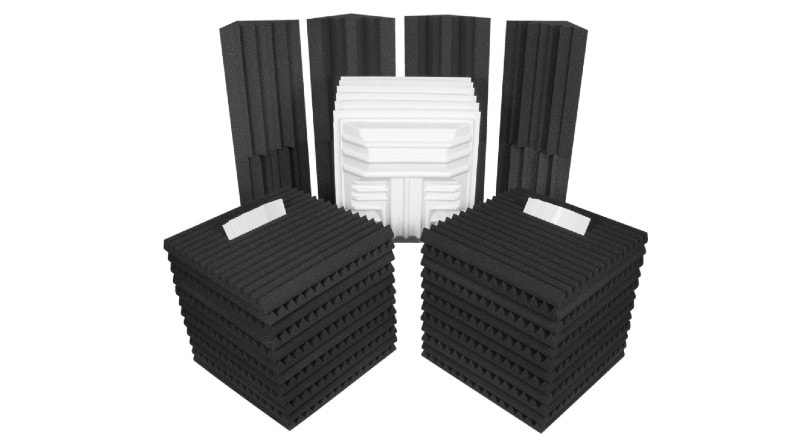
The ultimate turnkey soundproofing panel kit.
Unlike most soundproofing panel brands, Auralex offers a number of full turnkey packages, including their top-of-the-range set, the Deluxe Plus Roominator Kit took our KGR Editor’s Choice award in this test. It contains a range of different sizes and styles of panels, including 24 2’ x 2’ 2”-wedge Studiofoam panels, 8 LENRD bass traps, 6 T Fusers and all the adhesive you’ll need to mount each piece.
One of the best parts of ordering this kit is the free room analysis that Auralex offers. Before placing an order with our Sweetwater Sales Engineer, we contacted Auralex via their website with a diagram and the dimensions of the room we’d be installing the panels in. They replied with a layout diagram showing the optimum location in the room for each panel. It really took the guesswork out of the setup and ensured we got the best possible results.
We were absolutely blown away by the effectiveness of this kit. It did knock off more of the room acoustics than the other gear we tested during our acoustic and vocal test, but in all honesty, the resulting sound quality was incredible. Blanketing the walls with foam would undoubtedly just kill the room, but the custom room analysis from Auralex kept just enough of the qualities we wanted.
For a close-mic setup on an amp, it doesn’t get much better. This kit had both our clean and dirty recordings sounding like they’d been captured in a purpose built studio. The pieces are made to the highest standards and are clearly built to last. With this kit up, there’s no avoiding the fact that your room will look like a studio, but the kit is available in other colors (we had charcoal) if you want a more exciting look.
Of course, the Roominator kit stopped the most sound leakage by far, so it’s going to be great if your home studio shares an adjacent wall with a neighbor in a townhome or condo, and it’ll also help to eliminate outside noise from polluting your recordings.
Verdict: It’s not a cheap kit, but for the best possible home recordings, an investment in the Auralex Deluxe Plus Roominator Kit is highly advised. Because of their free analysis service, this is as suitable for complete beginners and seasoned pros alike. You get everything you need to prep your room for the best recordings you’ve ever made.
Auralex Wave Cave Royale
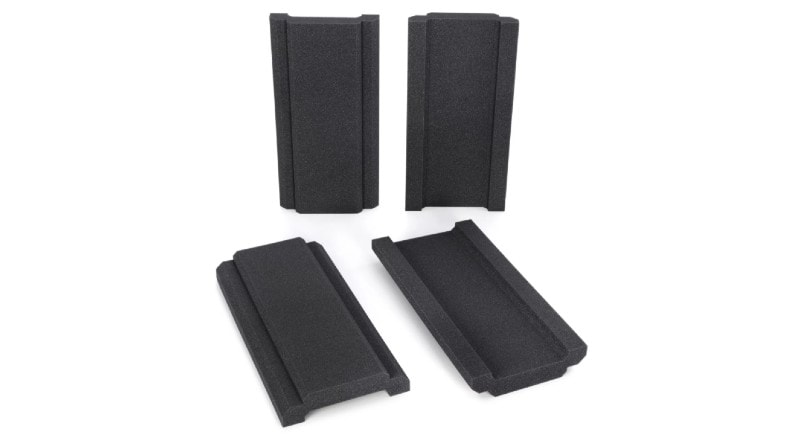
A contemporary take on the traditional acoustic foam panel.
Auralex really are at the forefront of soundproofing tech and this is absolutely apparent with these Wave Cave Royale panels. They are designed with an air pocket in the center to improve overall sound attenuation. They come in a number of different sizes, but we went with the 1’ x 2’ panel 4-pack.
Our first observation was that these panels are a little trickier to mount than a standard flat-back foam panel. The Wave Cave design leaves you with a smaller surface area for adhesive and over time, this is likely to lead to panels falling down.
As with most products from Auralex, we were really happy with the sound performance, though. On the acoustic recording, we found that with one panel on each wall, we cut down more room noise than with the Gator panels, but this was expected given that each panel was 2 sq ft, double the size of the Gator Pyramid panels. Still, we got some nice reverb without harsh echo.
On the close-mic test, we got some strong results. The clean recording picked up a little reverb from the room, but nothing that couldn’t be fixed in the DAW. The distorted recording was a touch muddier then we’d hoped it would be. It wasn’t bad, but the panels killed quite a bit of the mid and high frequencies, resulting in a slight loss of clarity.
As for reducing noise in adjacent rooms, these panels did a good job of taking the edge off, but didn’t do a lot for stopping external noise getting in. We did like how they looked, the rectangular design gives them some appeal, and like other Auralex products, they are available in other colors.
Verdict: The Auralex Wave Cave Royale soundproofing panels are a great choice if you’re looking for something that looks good and offers strong performance on acoustic guitars, vocals, and cleaner electric recordings.
Primacoustic Broadway Scatter Blocks
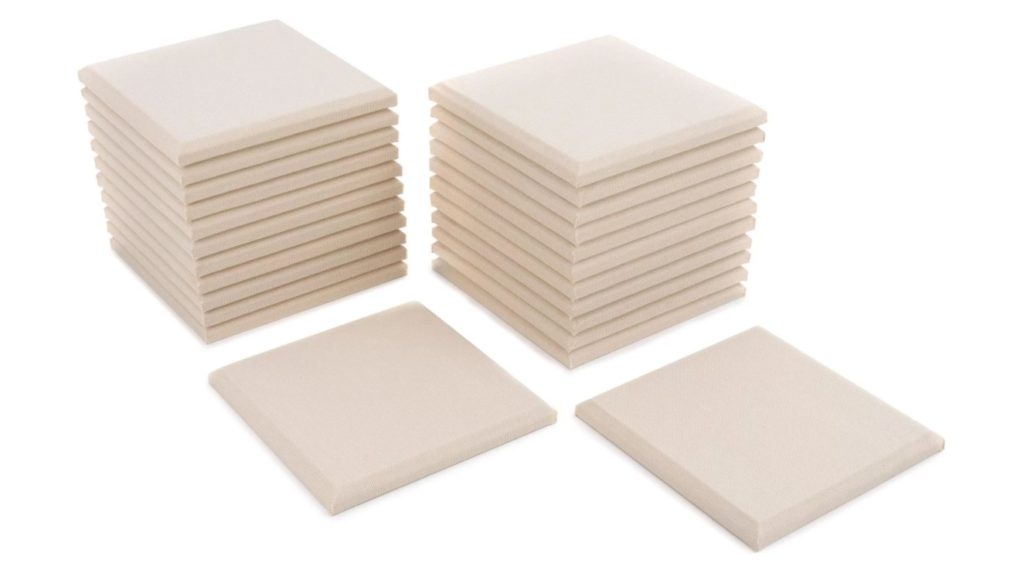
Premium finish and excellent versatility.
These Broadway Scatter Blocks from Primacoustic offer an alternative to open-cell foam, in a smaller package. They are made from high density (6lb ft³) fiberglass wool and offer excellent control over flutter echo and reverb. As these panels are heavier, it is definitely recommended to hang them wherever you have studs available.
Like Auralex, Primacoustic offers some layout advice on their website, although these recommendations are all computer-generated and don’t have the human input that Auralex offers.
After choosing a recommended design for the size and shape of our room, we got started. These panels come in a 24-pack, so we had a lot to hang. Once they were all up, we got right to work with an acoustic guitar and vocal track. Because we left quite a bit of reflective space between the panels, we got some great results for the acoustic and vocals. We definitely got the soft diffusion we were looking for without killing the room.
When it came to close-mic work on an electric guitar, they performed really well. The clean recording came out nicely without any excess coloration from the room. The distorted track lost a fair bit of bass, and came out somewhat trebly. It wasn’t a bad recording, but having heard what was possible with the Roominator kit, we expected more from this high-end gear.
We really liked how these panels looked. Our samples were in the beige finish, which looked great on the walls, but will almost certainly be difficult to keep clean. The canvas covering had the type of finish that acts as a magnet for dust and is difficult to clean. They do also come in grey and black, so consider an alternative color if you’re concerned about dirt.
Their ability to keep noise in and out from adjacent spaces was impressive. We did have 24 sq ft of high-density soundproofing panel on the walls, so they of course did have an advantage over the smaller packs we sampled, but that’s to be expected.
Verdict: The Primacoustic Broadway Scatter Blocks are a good middle ground if you’re looking for a lot of room coverage with premium panels, but you don’t have the budget for the Roominator kit. They handled the acoustic and vocal tracks well, as well as the clean electric, but they did kill more of the bottom end frequencies than we would have liked. This isn’t too major of a concern, as this can be addressed during editing.
How To Choose the Right Panels for You
Choosing the right acoustic soundproofing panels can be tricky. No worries, though. We’ve used our experience to simplify it all in this guide. We’re here to help you make the best choice for your needs in 2023 and beyond.
What Are Acoustic Soundproofing Panels?
Before talking specifically about the panels, we need to define “Soundproof”. To be completely soundproof, a material needs to be able to block 100% of the sound from entering or escaping the room that it is set up in.
So, when we think about acoustic soundproofing panels, we need to keep expectations in check. These panels will not completely prohibit the entry or egress of noise from a space. Instead, these panels will (in some cases significantly) reduce the entry or escape of sound.
When sound waves encounter hard surfaces, particularly smooth and shiny ones, the majority bounce back and reverberate around the room. Some of the sound waves do get absorbed into the structure of the wall, but the wall then vibrates, acting like the soundboard of a guitar, passing sound on to other rooms.
Acoustic soundproofing panels are normally made of foam or fiberglass. These panels don’t reflect sound as readily as a hard surface, nor do they vibrate when they absorb sound. This helps to reduce room reverb, diminishing escape or ingress of sound.
Of course, the more panels you put up, the more effective the soundproofing is. If your ultimate aim is to get as close to truly soundproof as possible, you’ll want to cover all of your walls, the floor, and ceiling in panels. If you’re just looking to improve room acoustics by reducing echo and you don’t necessarily want to kill the room, placing panels around the walls but leaving some reflective space will accomplish this goal.
In order to further dissipate sound energy and break it up, you will also find that many soundproofing panels have textured surfaces like checkerboard style ridges, or are shaped like egg cartons. In doing so, the surface area of the panel is increased, further increasing the amount of sound-wave absorption.
What to Look For in Soundproofing Panels?
When you’re looking for panels, there are a few areas to keep in mind:
Material
Beware the cheap foam panels found on Amazon and similar sites. Yes, you may be able to cover your entire room at a fraction of the price, but the foam used in these packages is extremely susceptible to deterioration, especially if it’s exposed to any kind of UV. It also generally tends to smell awful and often isn’t cut straight.
Similar styles of foam are used in more premium products, but you’ll see much more consistent panels, a lack of chemical smell, and resistance to crumbling over time.
Fiberglass panels are also available. Fiberglass is much heavier than foam, and it’s this mass that improves its soundproofing qualities. These panels tend to be more expensive, but are extremely hard-wearing. Larger panels especially will need to be mounted on stud to prevent the weight from damaging your drywall.
Design and Color Options
Especially if your recording or practice room is a shared space, having soundproofing panels that look presentable even when you’re not recording is going to keep everybody happy. Most of the top manufacturers usually have a few color options for their products, and often you’ll even see different textures available on foam panels.
The panel’s texture does add an interesting look, but it’s entirely functional, of course. So whether pyramids, egg carton, ridges, or checkerboard, each style will contribute to the overall soundproofing or sound management of the space.
Mounting Options
Most panels don’t come with any kind of pre-prep for mounting. Rigid panels will require that you install hanging hardware yourself, and most foam panels will need to be mounted on wood or cardboard before hanging. Better foam kits will at least come with adhesive strips to help you stick the panels to the backing of your choice, but it’s often the case that more adhesive is necessary.
Final Thoughts
Getting control of the sound in any room in which you plan to play guitar or record is really essential. Reducing sound bleed out of the room will keep your neighbors and those you live with happier. At the same time, you’ll have better sounding recordings and a more accurate representation of how your gear truly sounds.
In conclusion, the Clearsonic SORBER panels were a great choice for anybody looking to dip their toes into acoustic control without having too much to think about. If you’re working to a tighter budget, the Gator Acoustic Pyramid panels will definitely help you improve recordings without overspending. Anybody looking to take their recording to the next level and gain ultimate control over the sound of their recording or practice space won’t be disappointed with the Auralex Deluxe Plus Roominator kit.

